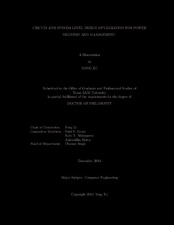| dc.description.abstract | As the VLSI technology scales to the nanometer scale, power consumption has become a critical design concern of VLSI circuits. Power gating and dynamic voltage and frequency scaling (DVFS) are two effective power management techniques that are widely utilized in modern chip designs. Various design challenges merge with these power management techniques in nanometer VLSI circuits. For example, power gating introduces unique power integrity issues and trade-offs between switching noise and rush current noise. Assuring power integrity and achieving power efficiency are two highly intertwined design challenges. In addition, these trade-offs significantly vary with the supply voltage. It is difficult to use conventional power-gated power delivery networks (PDNs) to fully meet the involved conflicting design constraints while maximizing power saving and minimizing supply noise. The DVFS controller and the DC-DC power converter are two highly intertwining enablers for DVFS-based systems. However, traditional DVFS techniques treat the design optimizations of the two as separate tasks, giving rise to sub-optimal designs.
To address the above research challenges, we propose several circuit and system level design optimization techniques in this dissertation. For power-gated PDN designs, we propose systemic decoupling capacitor (decap) optimization strategies that optimally trade-off between power integrity and leakage saving. First, new global decap and re-routable decap design concepts are proposed to relax the tight interaction between power integrity and leakage power saving of power-gated PDN at a single supply voltage level. Furthermore, we propose to leverage re-routable decaps to provide flexible decap allocation structures to better suit multiple supply voltage levels. The proposed strategies are implemented in an automatic design flow for choosing optimal amount of local decaps, global decaps and re-routable decaps. The proposed techniques significantly increase leakage saving without jeopardizing power integrity. The flexible decap allocations enabled by re-routable decaps lead to optimal design trade-offs for PDNs operating with two supply voltage levels.
To improve the effectiveness of DVFS, we analyze the drawbacks of circuit-level only and policy-level only optimizations and the promising opportunities resulted from the cross-layer co-optimization of the DC-DC converter and online learning based DVFS polices. We present a cross-layer approach that optimizes transition time, area, energy overhead of the DC-DC converter along with key parameters of an online learning DVFS controller. We systematically evaluate the benefits of the proposed co-optimization strategy based on several processor architectures, namely single and dual-core processors and processors with DVFS and power gating. Our results indicate that the co-optimization can introduce noticeable additional energy saving without significant performance degradation. | en |


